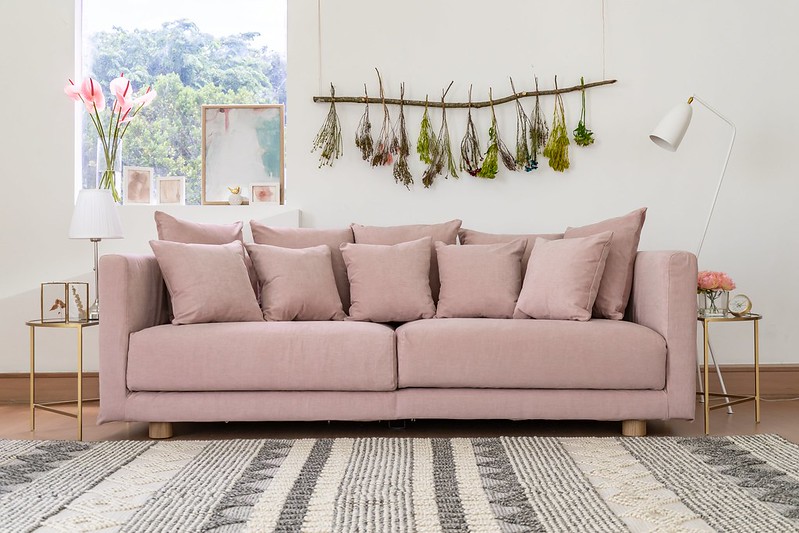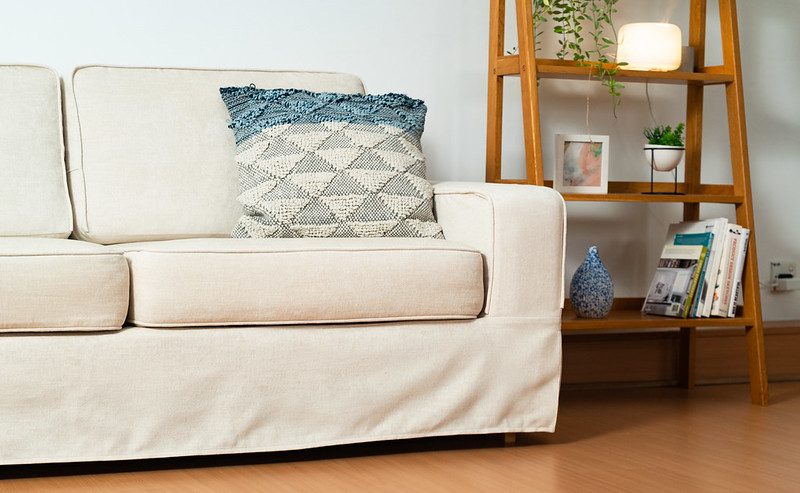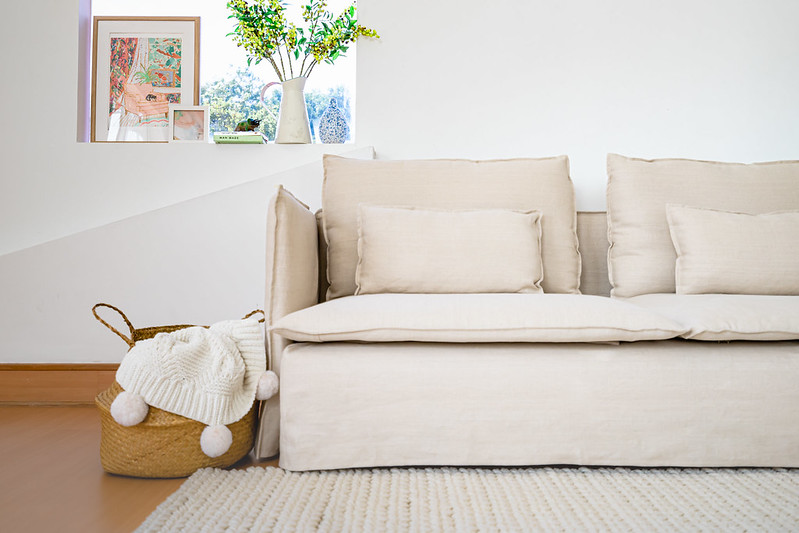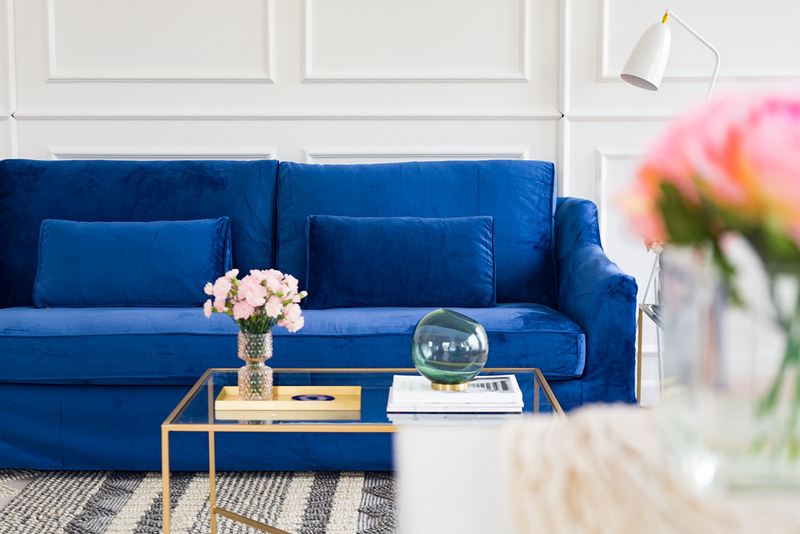After a long day, your sofa is exactly the place to be to curl up and unwind. Sometimes food and wine are involved. Sometimes your furry friends join in the fun. Other times, children. With crayons.
Let’s face it, when life happens, your sofa is the first to bear the brunt of it all. But that’s why you bought a fully removable slipcovered sofa in the first place – so that you can chuck the covers straight into the wash when you need to.
Of course, you don’t need to wait until there’s a major accident to wash your sofa covers. If you have pets, vacuuming their fur off the sofa should be a regular part of your sofa-cleaning routine. Fun fact: Excess germs and bacteria build-up on sofas is primarily caused by dead human cells! To keep this build-up to a minimum, avoid eating on your sofa (duh) and swap out your slipcovers between washes (at least twice a year).
Most slipcovers require two laundry loads: one load for cushions and the other for the body of the sofa. While nearly all slipcover types are machine-washable, different fabrics require a specific type of care. Here’s a general fabric care guide which you can follow when it comes to caring for your specific sofa slipcover fabric.
TABLE OF CONTENTS
1. Cotton slipcover care
2. Polyester slipcover care
3. Linen slipcover care
4. Velvet slipcover care
5. Leather slipcover care
6. Microfibre slipcover care
Cotton slipcover care

Cotton is one of the most common fabrics used to make slipcovers. It’s comfortable, durable and easily dyed in a variety of colours.
How to wash your cotton slipcovers
If your cotton slipcovers are machine-washable, put them on a cold, gentle cycle in your machine. The gentler the fabric is treated, the longer your slipcovers will last. If possible, try to wash the entire set in one go to maintain a consistent shade and finish.
Most cotton slipcovers will get softer after each wash, and darker fabrics may fade slightly, but that’s all part of a slipcover’s charm. Your slipcover should last several years, since most are washed just a few times a year.
How to dry and iron your cotton slipcovers
If you’ve heard of the practice of fitting covers on while slightly damp, it’s true! Leave them to drip dry in the shade for a few hours, and gently fit the covers on. They should slip on easier as they’re looser, and will allow for a nice, snug fit as the covers dry. Once the covers are fitted, keep the air flow around the sofa moving as much as possible – turn the fan on and keep the windows open.
If your covers need ironing, now is a great time to sharpen up the corners of the pleats and skirts. But wait until the covers are fully dry to iron the rest – wet ironing may stretch out your slipcovers.
How to spot clean cotton slipcovers
Moisten a clean cloth or sponge with water and press the cloth gently against the fabric. Work your way from the edges of the affected area into the centre, blotting the stain as you go.
Cotton slipcover care guide
- Machine wash not exceeding 30°C.
- Iron on medium heat.
- Do not bleach.
- Drip dry in shade only.
- Do not tumble dry.
- Do not wring.
- Do not expose to direct/indirect sunlight.
- Fit covers back on sofa when slightly damp.
- Vacuum upholstered furniture regularly.
- When possible rotate cushions regularly.
At Comfort Works, we offer two kinds of pure cotton slipcovers: Brushed Cotton, our silky, stonewashed cotton in five soft shades, and Cotton Canvas, a durable but comfortable cotton.
Find out more about our pure cotton slipcovers
Polyester slipcover care

Polyester is made up of strong and durable synthetic fibres. There is a wide range of polyester fabrics, and they are known to be soft, durable and hard-wearing. Often polyester is blended with natural fibres for the best of both worlds.
How to wash your polyester slipcovers
Most of the time, polyester covers are safe to be thrown into the washing machine, on a cold wash on the gentlest cycle of your machine. For extra protection, turn your slipcovers inside out before washing them.
How to dry and iron your polyester slipcovers
Before you throw the covers into the dryer, know that polyester is prone to melt under high temperatures. Polyester covers can hold up for a short time in the dryer, on a low temperature setting, but be careful not to leave them in there for too long. Zippers and velcro straps can also be worn down in a tumble dryer.
Generally, we recommend drip drying your covers in the shade, which shouldn’t take too long, as polyester covers don’t absorb much water and dry pretty quickly.
Polyester covers don’t wrinkle easily, so that should save you the job of ironing. If you’re after that crisp look, ironing the corners of skirts and the pleats inside out under low or medium heat should do the trick.
How to spot clean polyester slipcovers
Spot treatment for polyester fabrics is similar to that of cotton. Moisten a cloth/sponge with water and press the cloth gently against the fabric. Work your way from the edges of the affected area into the centre, blotting the stain as you go. Then, press clean towels against the damp fabric after the furniture has been cleaned. This will absorb excess moisture and speed the drying process.
Polyester slipcover care guide
- Machine wash not exceeding 30°C.
- Iron reverse side in low heat.
- Do not bleach.
- Drip dry in shade only.
- Do not tumble dry.
- Do not wring.
- Do not expose to direct/indirect sunlight.
- Fit covers back on sofa when slightly damp.
- Vacuum upholstered furniture regularly.
- When possible rotate cushions regularly.
At Comfort Works, we carry a range of different polyester and polyester blend fabrics, including our stain-resistant Performance Weave that’s perfect for families with kids and pets, our durable, commercial-grade Textured Weave, and our bestselling, super-versatile Everyday Weave.
Find out more about our Performance Weave slipcovers
Linen slipcover care

Linen is a strong, lightweight fabric that feels luxurious and smooth on the skin. It’s a great fabric for sofas because of its natural breathability and temperature-regulating properties, but can tend to the more expensive side. Linen fibres are also commonly blended with other fabrics, especially cotton, to create a more affordable, everyday fabric. Get to know why linen is the right fabric for you.
How to wash your linen slipcovers
Linens and linen blends require a little more care than cotton fabrics to keep them looking fresh and crisp. (Having said that, a characteristic of linen is that it will soften over time, and after each wash.) Linen covers are best machine-washed on a cold, gentle cycle.
How to dry and iron your linen slipcovers
Washable covers should be drip dried in the shade and fitted on the sofa when they’re almost dry but slightly damp. A slightly crumpled finish is part of linen’s signature look, so don’t worry about ironing unless you really want to. If you’re set on ironing your linen covers, it would be a good idea to iron while the fabric is still damp. Otherwise, iron with steam on the medium setting. While white linen is best ironed on both sides, it is best to iron dark linen on the inside only.
How to spot clean your linen slipcovers
Our recommendation is the tried-and-tested 50/50 white vineger and water mix. Mix equal parts white vinegar and water (white vinegar is a non-negotiable; do not try this with other types of vinegar!), pour the mixture into a spray bottle and then test the mixture on an inconspicuous part of the sofa first. If your linen covers don’t react adversely to the mixture, go ahead and spray the affected area, then dab it gently with a clean cloth.
Linen slipcover care guide
- Machine wash not exceeding 30°C.
- Iron on reverse side ONLY, on low heat.
- Do not bleach.
- Drip dry in shade only.
- Do not tumble dry.
- Do not wring.
- Do not expose to direct/indirect sunlight.
- Fit covers back on sofa when slightly damp.
- Vacuum upholstered furniture regularly.
- When possible rotate cushions regularly.
At Comfort Works, we carry a luxurious Pure Linen and also our Everyday Linen, a practical blend of 55% linen and 45% cotton.
Find out more about our linen slipcovers
Velvet slipcover care

The most traditionally luxurious sofa fabric, velvet is easy to love – but is it easy to take care of? Along with the textile industry, velvets have evolved over the years and these days they’re not that much more high-maintenance than any other fabric. Of course, there are a few things you need to look out for.
How to wash your velvet slipcovers
Comfort Works Classic Velvet and Claw-proof Velvet slipcovers are machine-washable, but we always recommend that you use a cold handwash setting. If you’re not confident in your washing machine, dry-cleaning is also a great option.
How to dry and iron your velvet slipcovers
Under no circumstances should you put your velvet covers into the dryer. Don’t do it! Drip dry them in the shade, and use a clothes brush to brush out the nap as it dries. This ensures that the fibres dry smoothly and will stay velvety after washing.
If your velvet slipcovers have lost their shimmer, you can use a steamer to restore its signature shine. Keep the nozzle moving across the velvet at a moderate pace in the direction of the nap. After it dries, use a soft-bristled hair brush and gently brush it in the direction of the nap.
How to spot clean velvet slipcovers
If there’s a stain on your velvet covers, you should always treat them prior to washing because if not, the stain might set and ruin the nap of the velvet, then you’ll be stuck with a patch of inconsistent nap on your couch.
Use a cloth dampened in lukewarm water and dab the stain gently, moving up and down. Dab with a dry cloth to clear up excess water. After trying to remove the stain, if it still appears to be there, then it’s best left to the dry cleaners.
Velvet slipcover care guide
- Cold machine wash/cold hand wash.
- Do not iron.
- Do not bleach.
- Dry clean recommended.
- Drip dry in shade only.
- Do not tumble dry.
- Do not wring.
- Do not expose to direct/indirect sunlight.
- Fit covers back on sofa when slightly damp.
- Vacuum upholstered furniture regularly.
- When possible rotate cushions regularly.
At Comfort Works, we have two velvets: our luxurious Classic Velvet, and our Claw-proof Velvet.
Find out more about our velvet slipcovers
Leather slipcover care

If you have allergies, leather is a great sofa material as it accumulates far less dust and mites than fabric does. And let’s get it out of the way: leather, in any form, is not washable.
Bycast leather is commonly used on sofas, and may be either completely synthetic, or a combination of real hide with a synthetic backing/coating. This coating also makes the leather stain-resistant and easier to keep clean.
How to clean your leather slipcovers
Using a dry cloth, wipe your sofa every few months to remove dust and grime that might cause wear and tear. For stubborn stains, mix three cups of water with a squirt of liquid dish detergent. Dip a cleaning cloth in this solution, wring out as much water as possible, then continue wiping until it’s all gone.
How to maintain leather slipcovers
After wiping, keep your bycast leather covers looking shiny and luxurious by buffing the polyurethane finish with a soft cloth. You can also find specialised conditioners and protectors designed for bycast leather furniture.
Leather slipcover care guide
- Do not wash.
- Do not iron.
- Do not bleach.
- Do not dry clean.
- Do not tumble dry.
- Do not wring.
- Do not expose to direct/indirect sunlight.
- Wipe with a dry cloth.
- Vacuum upholstered furniture regularly.
- When possible rotate cushions regularly.
At Comfort Works we have two leather options: our bycast leather Urbanskin Kramfors, and vegan leather Savannah Saddle.
Find out more about leather slipcovers here
Microfibre slipcover care
How to wash your microfibre slipcovers
It’s always good practice to vacuum the couch cushions with a soft brush, vacuum-cleaner attachment hose to suck up loose dust and dirt. Then set the washing machine to a gentle, delicate or hand-wash cycle. Fill the machine with cold water and add the proper amount of a mild laundry detergent as specified by the detergent bottle.
How to dry and iron your microfibre slipcovers
It’s crucial that microfibre fabric is not exposed to heat, so drip-drying your covers in the shade (near a fan) is always the best option. If you need to use the dryer, use the air-dry option which does not use any heat. While the covers are drying, use a clothes brush to brush them gently and restore the nap.
How to spot clean your microfibre slipcovers
The magic combination is rubbing alcohol, white scrub sponges, and a soft bristle brush. The results are amazing! All you need to do is spray rubbing alcohol on the stains, then use the white sponge to gently scrub the grime off. Once that’s done, use a soft bristle brush to fluff the fabric.
Microfibre fabric care guide
- Cold machine wash/cold hand wash.
- Do not iron.
- Do not bleach.
- Dry clean recommended.
- Drip dry in shade only.
- Do not tumble dry.
- Do not wring.
- Do not expose to direct/indirect sunlight.
- Fit covers back on sofa when slightly damp.
- Vacuum upholstered furniture regularly.
- When possible rotate cushions regularly.
Want to know more about our fabrics? Check out our comprehensive care guides & warranty!


137 Comments
by 日本史 貿易 まとめ
That if a visitor is injured in your property or causes damage to your private home, you will not be covered under your current policy.
https://paste.vpsfree.cz/gonkcb6j/+inline
by 源氏物語 掲示板
WhatsApp cannot see your shared location and neither can Fb.
https://paste.centos.org/view/604fe3cc
by 漢字 とひらがな 使い分け
Little India, Chinatown and the Kampung Glam are the city’s ethnic corners.
https://paste.firnsy.com/paste/v8yQzbFQnWy
by ユーアイバスの株価は
In immediately’s quick-paced hospitality environment, environment friendly management and distinctive guest companies are key to success.
https://paste.intergen.online/view/cb621f11
by イギリス総選挙 結果
Maude FIELDS of Bucklin, Kans.
https://paste.thezomg.com/245572/35332717/